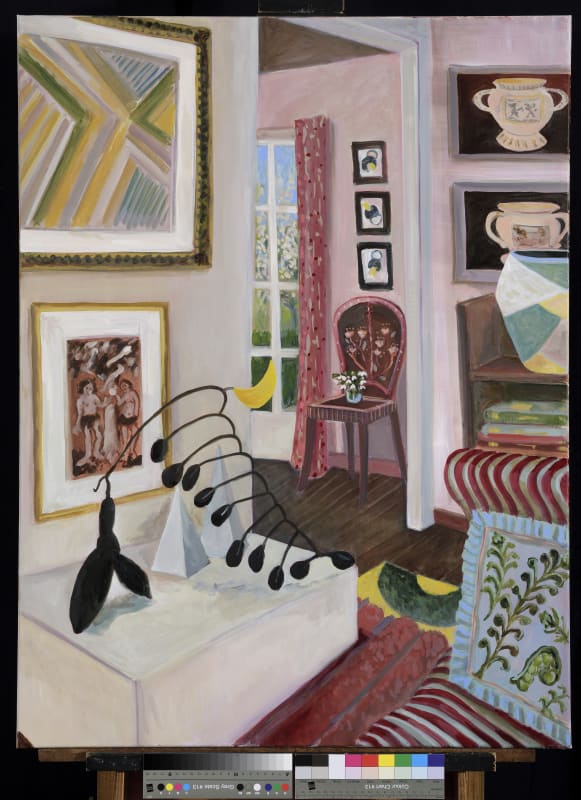 Harriet Olsen is the founder of Eiderdown Books, an independent publishing house established to get more books about female artists onto our bookshelves. The latest book from the ‘Modern Women Artists’ mini-series about the British artist and illustrator Eileen Mayo is out now. For more information or follow the story on Instagram @eiderdownbooks
Harriet Olsen is the founder of Eiderdown Books, an independent publishing house established to get more books about female artists onto our bookshelves. The latest book from the ‘Modern Women Artists’ mini-series about the British artist and illustrator Eileen Mayo is out now. For more information or follow the story on Instagram @eiderdownbooks
*******
"I would venture to guess that Anon […] was often a woman"
Virginia Woolf, A Room of One's Own
The rooms in Lottie Cole’s paintings are unoccupied. Whoever lives here hasn't
gone far, they have only stepped out of the room leaving us momentarily alone. A fire roars in the open hearth; a game of gin-rummy, interrupted mid-way through, has been left on a coffee table to be continued presently; a book has been hastily left behind on a window sill while matters outside this room are attended to. The flowers (everywhere) – whether abundant in over-sized vases, or simple posies of snowdrops placed into an artist’s mug on a mantelpiece – are fresh and open and have surely been picked from the garden only this morning.
This is a home, certainly: loved and inviting. We want to stay awhile, fall back into the plumped-up cushions and run our fingers reassuringly across a velvet armrest. But alone in this most lavish of English living-rooms, with its country garden - hollyhocks and all – pressed up against the windows, the temptation to take a closer look at that large, framed painting on the far wall while its owner is
briefly absent is impossible to resist. Intriguingly, doesn’t it seem familiar? And that bronze on the mantle-piece. And the decorated plates by the mirror… Like Dorothy, haven’t we somehow seen all this, someplace before?
Given temporary free-reign inside the home of our host we can enjoy the idiosyncrasies of someone else’s private tastes and relish this unfettered access to masterpieces which might otherwise only be seen publically in a museum’s temporary exhibition once in a lifetime. Fleetingly, for a little while at least, they belong to us. In this room and just for a moment we are spoilt for choice: ours alone to enjoy is the Elisabeth Frink head, a Marlow Moss double line, a Jessica Dismorr abstract.
There are layers of paint and layers of art histories embedded in Lottie Cole’s imagined living-rooms, but these domestic interiors are far removed from Walter Sickert’s austere and sparse drawing rooms or the solitary chair in the corner of Gwen John’s Parisian quarters. Even with circle-painted fireplace surrounds and hand-decorated lampshades, these rooms are beyond even Bloomsbury: we’re in an Instagram-like realm of private homes with a world of interiors pressed into the four corners of the canvas. Scheele’s poisonous Georgian greens are replaced with Farrow and Ball colour cards of pinks and yellows and blues, lime-washed across walls, abutting brightly patterned wallpapers which run towards brightly glazed tile fire surrounds and down again to zig-zagging carpets and rugs.
We might be reminded of Harold Gilman’s zingy patterned wallpapers in gloomy Edwardian houses, but it is more useful perhaps to look across the pond to another (unrelated but contemporaneous) Gilman: to the American novelist Charlotte Perkins Gilman and her 1890 semi-autobiographical short story The Yellow Wallpaper. In this cautionary tale our protagonist is imprisoned within a room, hidden from view, oppressed in equal measures by the ‘infuriating […] torturing’ patterned, yellow walls of her bedroom jail-room and society’s limitations on her sex. Like the mysterious woman who lurks, trapped behind the pattern of Gilman’s yellow wallpaper, Cole’s paintings too are filled with unseen, anonymous women: Vera Spencer, Helen Saunders, Mina Loy – all are far from being familiar, known, ‘household’ names.
The chairs of the Irish designer Eileen Grey – importantly one of the first women to be admitted to the Slade in 1898 but whose name has inexplicably dropped from wider recognition - become a focal point in Cole’s latest paintings, some with vases boasting, brim-full with cut flowers, shouting ‘Look at me! I exist!’ and demanding our attention. These chairs are as good as any by Mies van der Rohe or Le Courbusier (whose own tubular designs in fact came later). She is the pioneer. Her name and work need to be seen.
There is an exciting departure for Cole in this exhibition, as she continues her explorations beyond living-rooms with figurative groupings often found outside. Following on from her 2021 Ski Slopes holiday snaps series, now Barron and Larcher go shopping in a French market, Virginia and Angelica sit out in the dappled shade, and three anonymous sisters pose together on a garden lawn. Back inside, in Cole’s kaleidoscopic world of colour – in geometric rugs, in the patterns up the walls, in the circles on fireplaces, abstract paintings and sculptures, blousy floral arrangements, repeats on curtains and stripes on settees - we’re pulled up through a rush of art history and see that there exists a cacophony of women clamouring for recognition. It transpires they were there all along, these anonymous women. Hidden in plain sight, we needed only to look a little longer to see them.
Harriet Olsen
May 2022
